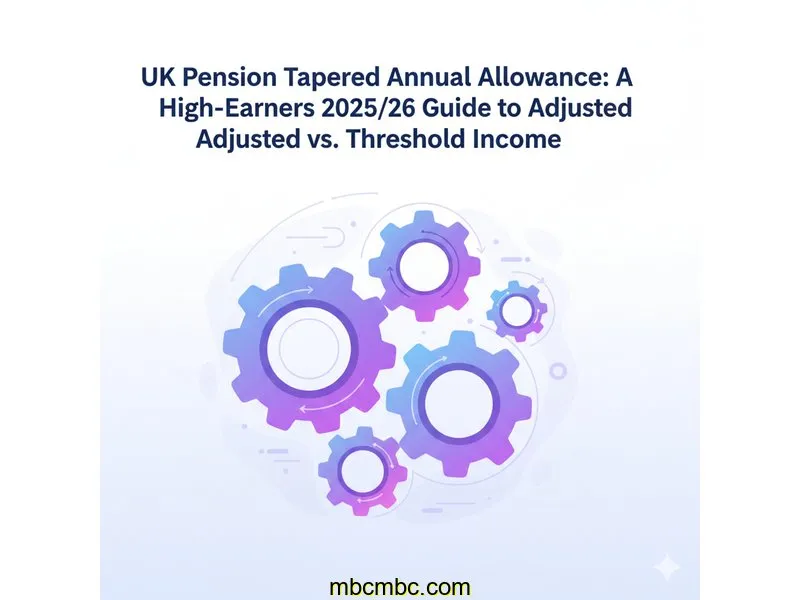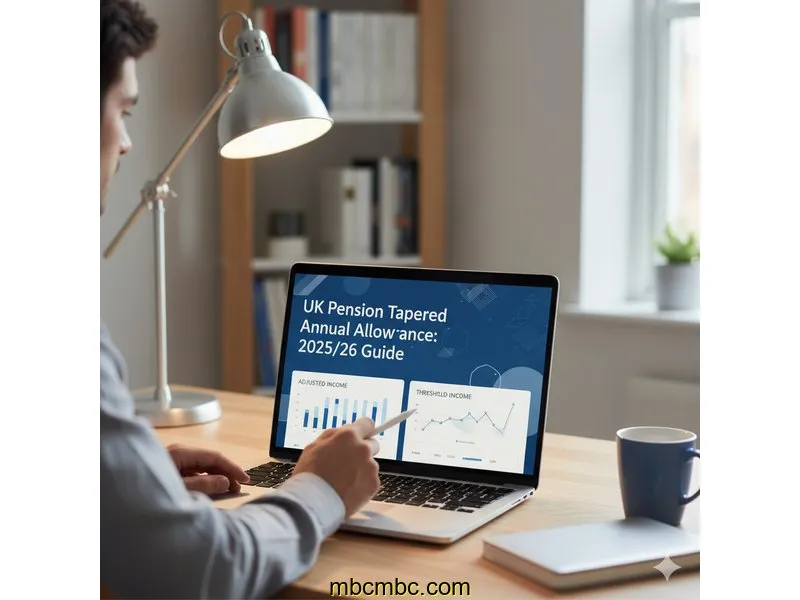
Picture this: You’re a successful UK limited company director in London who’s just had a stellar year, pushing your total income comfortably over the six-figure mark. You decide to max out your pension contributions to be tax-efficient—a smart move, right? Then your accountant drops a bombshell: you might be caught by the **Tapered Annual Allowance (TAA)**. Suddenly, instead of a tax-free retirement pot, you’re facing a complex tax charge.
If you've felt this confusion or worry about over-contributing, you’re not alone. The Tapered Annual Allowance is arguably one of the most complex pieces of UK tax legislation. Getting it wrong doesn't just mean losing tax relief; it can lead to a significant, unexpected tax bill. Since its introduction, the TAA has created a confusing ceiling for high earners, requiring them to calculate not one, but two distinct income figures—**Threshold Income** and **Adjusted Net Income**—to determine their maximum tax-relievable pension contribution.
Key Takeaways
- Threshold Income (£200,000): If your total income is below this, the TAA **does not apply**, regardless of your pension contributions.
- Adjusted Income (£260,000): This is the figure that actually determines the reduction in your allowance—if you exceed this, your Annual Allowance begins to taper down from the standard £60,000.
- Key Data Point: The government introduced new, higher TAA thresholds in April 2023, lifting the standard Annual Allowance to £60,000 and the Adjusted Income limit to £260,000 to encourage high-earners to save more for retirement (HMRC, 2023).
- When to Act: If your total income for 2025/26 is on track to exceed **£200,000**, you need to immediately calculate your Adjusted Income to avoid a tax charge.
- Disclaimer: This article provides informational guidance based on HMRC rules as of November 2025. It is not financial or legal advice. Pension and tax rules are complex and penalties for errors are significant—always consult a qualified financial advisor or accountant for your specific situation.
The Core Concept: Why High Earners Need Two Income Tests
The core concept behind the Tapered Annual Allowance is a balancing act: the government wants to incentivise retirement saving while limiting the most significant tax relief for the highest earners. The current standard Annual Allowance (AA) is **£60,000** for the 2025/26 tax year, but for those with very high incomes, this is reduced, or 'tapered.' The calculation requires two distinct tests, and they are defined differently.
Think of the TAA like a two-part security system on your retirement savings: the first check is a simple pass/fail gate, and the second is the exact key that determines how far the door closes. The **Threshold Income** test is the simple gate: if you pass that test, you can ignore the taper completely. If you fail, you move on to the more complex **Adjusted Income** calculation, which determines the severity of the taper.
This matters because HMRC data shows that the TAA most significantly impacts high-earning self-employed professionals, such as consultants and partners in professional firms, who often rely on large, one-off pension contributions for tax planning (ONS/HMRC, 2024). Understanding the difference between these two figures is the only way to accurately manage your contributions.
Threshold Income vs. Adjusted Income: The Definitive Breakdown
The definitions of these two figures are crucial, and the distinction often confuses even experienced business owners. The core difference lies in whether your **own** pension contributions are included or excluded, and whether the **employer's** contributions are included.
1. Threshold Income (The Pass/Fail Gate: £200,000)
The Threshold Income test checks if your income is high enough to trigger the taper in the first place. This is your simplest figure:
- **Start:** Your total taxable income (salary, dividends, interest, rental income, etc.).
- **Subtract:** Any personal pension contributions made under the ‘net pay’ arrangement or by 'relief at source' (which means your contributions are taken *before* tax relief is added).
The key here is that **your own pension contributions are deducted**. The intent is to give people who are already trying to manage their income via their own contributions a way to avoid the TAA. The **£200,000** limit is high enough that if you stay under it, you keep the full £60,000 Annual Allowance.
2. Adjusted Income (The Calculation Key: £260,000)
If your Threshold Income is over £200,000, you proceed to calculate your Adjusted Income. This is the figure that tells you *how much* your Annual Allowance reduces by. This is where the calculation shifts dramatically:
- **Start:** Your Threshold Income figure.
- **Add Back:** All personal pension contributions.
- **Add:** **All employer pension contributions** made on your behalf (including those made via salary sacrifice).
In essence, **Adjusted Income includes all pension contributions from all sources**. This is a measure of your *true* total economic resource for the year, regardless of how much of it has gone into your pension. If your Adjusted Income exceeds **£260,000**, the tapering begins.
Scenario-Based Breakdown: The Key Differences in Action
To make sense of this, let's break down the rules for three common high-earning scenarios. The table below shows exactly how two people with similar total economic resources can have wildly different TAA outcomes based on how their pension is funded.
| Customer Scenario | Threshold Income Calculation | Adjusted Income Calculation | Annual Allowance Result | What You Must Do |
|---|---|---|---|---|
| **Scenario A (Freelancer):** £210k Taxable Income; £10k Personal Pension Contribution (Gross) | £210k - £10k = **£200,000** | £200k + £10k = **£210,000** | **Full £60,000 AA.** Threshold Income is exactly £200k. Tapering does not apply. | Continue contributions up to the £60k AA. |
| **Scenario B (Director):** £180k Taxable Income; £40k Employer Contribution (via Salary Sacrifice) | £180k. **Below £200k.** | £180k + £40k = **£220,000** | **Full £60,000 AA.** The Threshold Income test is the only one that matters here. If it is below £200k, you are safe. | Maintain contributions. The TAA is avoided. |
| **Scenario C (Consultant):** £215k Taxable Income; £50k Employer Contribution | £215k. **Above £200k.** (Tapering is triggered) | £215k + £50k = **£265,000** | **Tapered AA.** Adjusted Income is £265k (over the £260k limit). Taper is applied. | Calculate the taper and potentially use Carry Forward. |
The table reveals a powerful planning tool: the **Threshold Income** of £200,000 is the figure to manage if you wish to avoid the entire complex calculation. If your taxable income (after your own pension contributions) stays below this, you secure the full £60,000 Annual Allowance, regardless of how much your employer pays in on your behalf.
The Deep Dive: How the Taper Works and the Minimum Allowance

If you fail the Threshold Income test (over £200,000) and your Adjusted Income is over £260,000 (as in Scenario C), the actual tapering mechanism is applied. Your £60,000 Annual Allowance is reduced by **£1 for every £2** that your Adjusted Income exceeds £260,000.
Let's use a clear example. Consider a high earner whose **Adjusted Income is £300,000**:
- **Excess Adjusted Income:** £300,000 - £260,000 = £40,000
- **Taper Reduction:** £40,000 / 2 = £20,000
- **New Tapered Annual Allowance:** £60,000 - £20,000 = **£40,000**
The tapering continues until the Annual Allowance hits its absolute minimum, which is currently **£10,000**. This minimum is reached when the Adjusted Income hits **£360,000** or more (HMRC Pension Tax Manual, 2025). This floor, combined with the new, higher £60,000 starting point, ensures that even the highest earners still benefit from substantial tax relief. According to recent UK government tax modelling, only those with the very highest incomes will hit this £10,000 floor in the 2025/26 tax year (UK Parliament Research Briefing, 2024).
The £10,000 Minimum Annual Allowance Threshold
If your Adjusted Income is **£360,000** or more, your Annual Allowance is set at the minimum of **£10,000**.
If your Adjusted Income is between **£260,000** and **£360,000**, your Annual Allowance is calculated as: **£60,000 - (Adjusted Income - £260,000) / 2**.
If your Threshold Income is below **£200,000**, your Annual Allowance is the **full £60,000**.
Edge Cases: Salary Sacrifice and Carry Forward
The Tapered Annual Allowance interacts with other pension rules, creating important edge cases for high earners:
The Salary Sacrifice Nuance
Many high earners use a **salary sacrifice** arrangement to make pension contributions, as this reduces both employer and employee National Insurance contributions. Here's a crucial point: contributions made via salary sacrifice **do not** reduce your Threshold Income because they are considered employer contributions. This means a significant salary sacrifice can keep your Threshold Income *low* but will push your Adjusted Income *up*. For most, managing the Threshold Income to stay below £200,000 is the cleanest way to bypass the taper entirely.
Carry Forward Rules
If you have been caught by the TAA, you might still be able to make large contributions by using the **Carry Forward** rule. This allows you to utilise unused Annual Allowance from the three previous tax years. However, if the taper applies to the *current* tax year, you must use your *tapered* Annual Allowance figure for that year's calculation. This is a powerful, yet complicated, strategy that allows high earners to retrospectively manage the impact of the TAA on past years.
Common Questions About the Tapered Annual Allowance
Based on questions I've seen across UK business owner forums and Reddit's r/UKPersonalFinance, here are the three most common points of confusion.
Does my Director’s Dividend Income Count Towards the Taper?
Yes, absolutely. Both your director's salary and all dividend income (after the Dividend Allowance) are counted in both the Threshold Income and Adjusted Income calculations. The only income not counted is generally non-taxable income (like ISA interest or the first £1,000 of trading/property allowance). For most limited company directors, dividends are the primary driver that pushes them past the £200,000 Threshold Income gate, so they require careful planning.
If my Threshold Income is below £200k, do I still need to calculate Adjusted Income?
The beauty of the two-part test is that you don't. If your Threshold Income is £200,000 or less, you can stop the calculation. The Tapered Annual Allowance rule simply does not apply to you for that tax year. Your allowance remains the standard £60,000 (plus any Carry Forward you may have). This is why managing personal pension contributions to bring your taxable income just under the £200,000 threshold is a popular and very effective planning strategy.
Can I use Carry Forward from a year when the taper applied?
You can, but you must use the correct figure. If you were caught by the TAA in a previous year (say, 2023/24), you must use your **tapered** Annual Allowance for that year, not the standard £40,000 or £60,000. For example, if your AA was tapered down to £25,000 in 2023/24 and you only contributed £10,000, you have £15,000 of unused allowance from that year to carry forward. You cannot carry forward the difference between £60,000 and £10,000.
Conclusion: Your Next Steps
Understanding the UK Tapered Annual Allowance comes down to two core income figures: **Threshold Income** (the pass/fail gate at £200,000, which you can reduce with personal contributions) and **Adjusted Income** (the calculation key at £260,000, which includes all contributions). By tracking your income against these two limits throughout the 2025/26 tax year, you can manage your contributions to maximise tax relief without incurring a punitive tax charge.
If you're a high-earner or limited company director, your next step should be an audit of your year-to-date income and contributions against the £200,000 Threshold Income. For most, managing this figure to stay below the limit is the most straightforward path to securing the full £60,000 Annual Allowance. Remember, pension tax rules are intricate, highly personalised, and subject to change—this guide provides a framework, but for your specific financial future, always consult a qualified financial advisor who specialises in high-earner pension planning.

